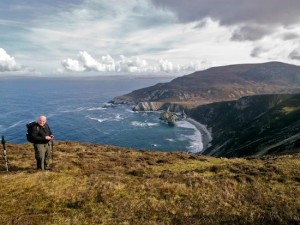Sydney Morning Herald reporter Julietta Jameson recently spent some time in Donegal. To say she was impressed is a bit of an understatement. Here is her account of her time spent in our wonderful county.
“Three children are giggling musically as they take turns to roll down a grassy levee that rises to meet the gravel drive out front of Rathmullan House, a lovely old mansion hotel on the shore of a fjord near Ireland’s most northerly tip. At the advancing crunch of my tyres, they pick themselves up and form an excited line, then give a a hearty wave as I pull up. “We’re on holiday,” one of them exclaims with a beaming smile the second I step out of my car.
“It’s the weekend when not just those children, but all of Northern Ireland is on holiday, the commemoration of Orangemen’s Day. “And if they’re not at home marching, then they’re by the seaside here in County Donegal,” a service station attendant had told me earlier in the day. Given that Donegal is unique to the Republic of Ireland in that it shares a tiny bit of its border with one compatriot county and the rest of it with three United Kingdom counties, its coast represents the closest seaside for many a Northern Irish. Just on a practical level, it makes sense that they would come here. But there’s a transcendent quality to the Donegal coast that makes me think: if you had the choice to holiday here, why would you holiday anywhere else?
“Ireland generally is a country of gob-smacking beauty, but Donegal is the Ireland I always imagined from those storybooks and poems of my childhood: vibrant fields that look like slicks of thick green oil paint; impossibly pretty (and preserved) villages full of white wash and burgeoning window boxes; rambling forests that may or may not be enchanted and waterfalls lurking in mysterious glens; sparkling lakes and monolithic mountains; ancient ruins everywhere and, in the parts I’m touring, the constant presence of the Atlantic Ocean, glistening a surprisingly tropical blue thanks to the white, white sand of the coastline.
“How to take it all in? The best itineraries, I reckon, have a treasure hunt aspect to them. They don’t need enormous amounts of research – they just need to take you somewhere, preferably off the beaten track. And so here I am in County Donegal, touring its coast, the northern most stretch of Ireland’s Wild Atlantic Way, a 2500-kilometre, newly defined driving experience. And I’ve got some treasure in mind.
“In my childhood home we had a brown wooden statue of a long-necked seal-like creature with green diamante eyes – a selkie, Mum said, a figure of Celtic myth, a seal that can shed its skin and take human form. I loved that little ornament and always loved the idea of the shape-shifting selkies in the Irish fairytales we were fed. Years later, one of my favourite film makers, John Sayles, made a movie about selkies set in Donegal, called The Secret of Roan Inish.
“The locations in which the film was shot were magnificent but I knew not where – it came out in 1994, before Google enabled us to find out everything. Then in 2014 the opportunity arose for me to travel to Donegal and a quick bit of research revealed it had been shot in two primary locations: the small coastal villages of Rosbeg and Portnoo. (What a difference two decades of technology make.)
“So on my first day in Donegal I set the GPS to “avoid highways”, punch in Rosbeg and Portnoo and that robotic voice is wonderfully, pushing me up hill and down dale, left, right, left again along skinny back roads and farm lanes lined with overgrown hedgerows full of wild fuchsia and ferns that break to reveal sweeping views of the Atlantic.
“It’s not long till I pass through the postcard-perfect town of Ardara, backed by the vast V of the glacially-carved Glengesh Pass. Ardara is home to a hugely popular annual walkers’ festival and on this summer day, there are plenty getting in early practice. The road to Rosbeg is peppered with happy pedestrians.
“The Wild Atlantic Way, at least this bit of it, is not a singular thing like say, the Great Ocean Road. Particularly in Donegal, where the land meets the sea in a raggedy and ripped fraying, it can be a matter of choice. The super quick, super smooth N56 gets you easily and quickly south to north from Donegal Town to Letterkenny, the most populous of County Donegal centres, but ocean-side of it is where the Wild Atlantic Way winds, a series of labyrinthine narrow roads that hug bulbous peninsulas, ribbon-like inlets and star-shaped harbours.
“Rosbeg and Portnoo share one of the little peninsulas and the road to it from Ardara soon narrows to a twisting, turning single lane challenge. But how I gasp when I catch a glimpse of Rosbeg with each twist. And then I’m finally down into the tiny hamlet, a collection of houses fronted by sandy beaches sheltered in jagged rock formations. I finally find a spot to pull my car off the thin road and get talking to the sole family on the beach nearby. I ask when it gets busy. “It’s a big holiday weekend in the north. This is busy,” one member says, then adds, “Buses can’t get down here. One or two have tried.”
“I sit in the rocks for a while and feast on the peace and the textures and colours: white marble against black rock, vibrant lichens, seaweed and moss, heather fluffy as down underfoot and carpets of wildflowers of purple, yellow, pink and white. And that squeaky, creamy sand. The only sounds, apart from the lap of the ocean are the tinkle of boats and some kids playing badminton on the lawn outside a house on a nearby hill. I’m coming back here, I think.
“I push on to Portnoo on a track that hugs the coast in parts and cuts through stone-fence crossed paddocks in others. The Portnoo reveal is another gasp-worthy moment: the town gazes out to a huge expanse of white sand and the grassy paddock of Inishkeel, sea-locked except at low tide when you can walk on the sand out to it. I get talking to some locals sunning themselves outside a roadside holiday bungalow and tell them of my Secret of Roan Inish quest. “Some of the film was shot on Inishkeel,” one says.
“But you know Roaninish is a real place,” another says. “It’s a little island and a nature reserve. We often go out there on the boat for a picnic. On a clear day you can see it from the main house.” Without hesitation and without me asking, she takes me up to the main house balcony but alas, the day is not clear enough to see Roaninish. We have a lovely cup of tea. And it’s enough to know it’s out there.
“In the ensuing days I explore more of the Donegal coast’s myriad wonders: the dramatic cliffs at Slieve League, the craic in beautiful Donegal Town and Killybegs harbour, the startling brutal rise of Errigal mountain. There are gasps aplenty.
“And then I arrive at Rathmullan House, hidden in the back of a perfect Irish seaside village, down a long woodland drive, a seaside manor worthy of the Mitfords. There are couple strolling arm in arm with their dogs at their feet, others reading newspapers while sipping beers as their children play on the lawn. From my room with its view of Lough Swilly fjord, I spy the little girl who greeted me earlier, still there on the grass. She throws her arms out and spins round and round till she collapses on the lawn.
“It’s a happy place; a beautiful place – I’ll come back here too, I think. It’s a good place for selkies. Just like all the Donegal coast.”
Tags:









